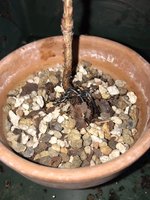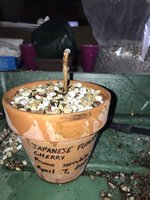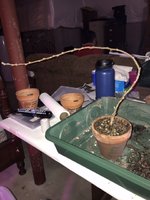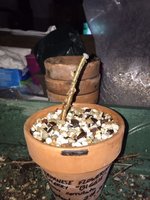Haines' Trees
Shohin
Hey y’all!
So I’ve got a couple of Japanese flowering cherries that I grew from seed last season. Planted them late in the year, so they didn’t have much of a first season before going dormant
This year, I’ve had one in particular that has taken off quite well. Currently standing at just shy of 2 feet tall, Ive had to throw a bit of “scaffolding” onto it out of concerns that a windy day will do it some harm.

And a look at the low trunk (you can see the little stick that is the last evidence of its first, short growing season)

This is the first species of flowering tree I’ve ever had and the most successful deciduous I’ve grown from seed myself, so onto the question at hand: what the hell to do from here? It’s had explosive growth and I’m tempted to wire some movement into it while it’s dormant. In early spring I figure I’ll check the roots and perform a repot if needed. I know summer trimming is something to do with many deciduous but I skipped it on these on account of their age but now I’m wondering if I shouldn’t have. I have no plan as of right now for this tree since I didn’t think I would see this type of size so quickly. Thoughts? Advice?
So I’ve got a couple of Japanese flowering cherries that I grew from seed last season. Planted them late in the year, so they didn’t have much of a first season before going dormant
This year, I’ve had one in particular that has taken off quite well. Currently standing at just shy of 2 feet tall, Ive had to throw a bit of “scaffolding” onto it out of concerns that a windy day will do it some harm.

And a look at the low trunk (you can see the little stick that is the last evidence of its first, short growing season)

This is the first species of flowering tree I’ve ever had and the most successful deciduous I’ve grown from seed myself, so onto the question at hand: what the hell to do from here? It’s had explosive growth and I’m tempted to wire some movement into it while it’s dormant. In early spring I figure I’ll check the roots and perform a repot if needed. I know summer trimming is something to do with many deciduous but I skipped it on these on account of their age but now I’m wondering if I shouldn’t have. I have no plan as of right now for this tree since I didn’t think I would see this type of size so quickly. Thoughts? Advice?















